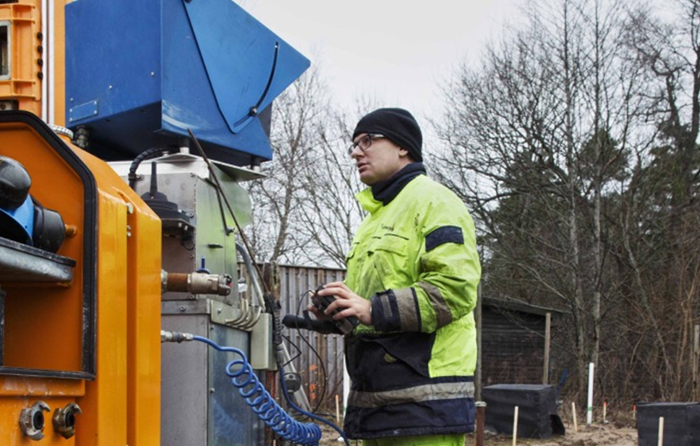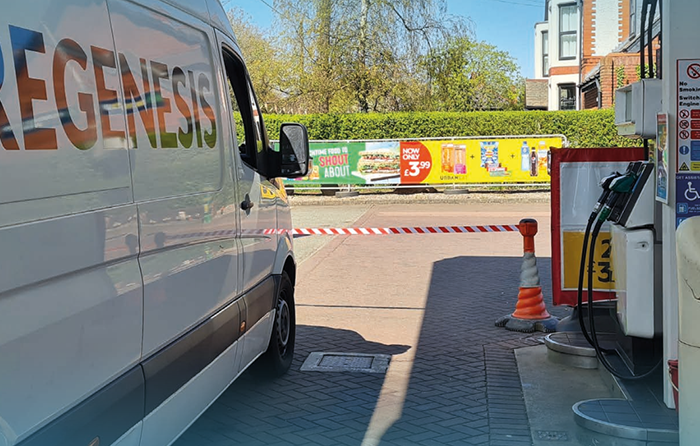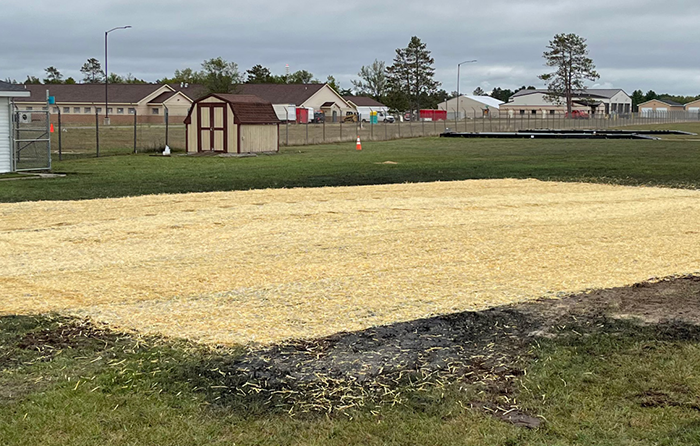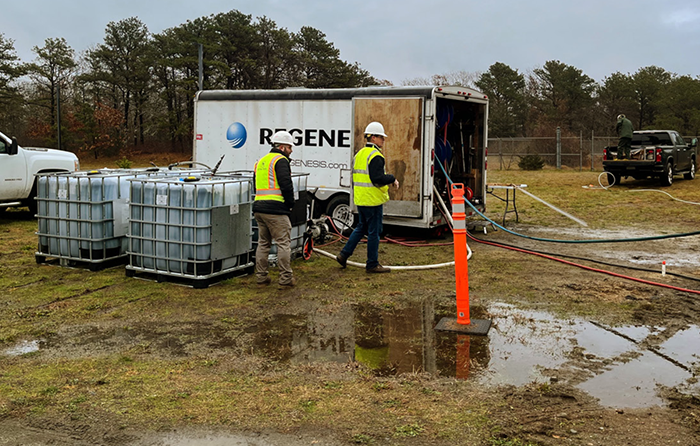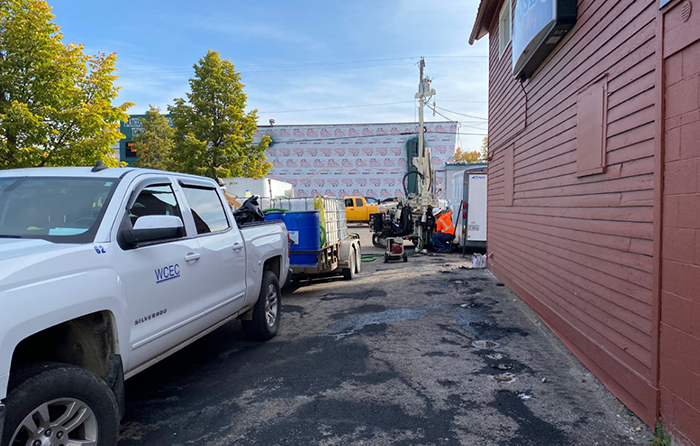In-Situ Chlorinated Solvent Treatment Protects Municipal Drinking Water
Case study highlights:
- Remediation solution from REGENESIS protects municipal water pumping station from chlorinated solvent contamination
- Following injection the PCE was rapidly degraded by 99.98%
- Long term monitoring shows that no rebound in parent or daughter contaminant concentrations has occurred
This case study reviews a site in Sweden where a single injection of REGENESIS controlled release electron donor technology resulted in the degradation of the contaminant plume and protection of a downgradient drinking water pumping station. Environmental consulting firm RGS Nordic worked with REGENESIS to design an in situ remediation solution for the chlorinated solvent plume. In situ remediation using Enhanced Reductive Dechlorination (ERD) was chosen to provide the most cost-effective solution for the groundwater plume. Prior to application, the contaminant plume primarily consisted of PCE with a small amount of daughter products. Following injection the PCE was rapidly degraded by 99.98%. All daughter products were degraded sequentially and the presence of ethene showed that full reductive dechlorination had occurred.
PetroFix Barrier Prevents Offsite Risk at Active Gas Station
Case study highlights:
- Groundwater samples taken post-application demonstrated that all remedial objectives had been met
- PetroFix IPRB was the most sustainable option for the site
- Application completed at a significantly lower cost and in less time than pump and treat
This case study reviews an active gas station in the United Kingdom where dissolved phase contamination at high concentrations in groundwater migrated beyond the site boundary, resulting in a potential off-site liability. An in situ permeable reactive barrier (IPRB) using PetroFix colloidal activated carbon was installed to prevent offsite risk. Environmental consulting firm SLR Consulting partnered with REGENESIS to design and apply the solution, which met site objectives within 12 months. The PetroFix IPRB was the most sustainable option for the site; compared to a source excavation approach, the project prevented up to 55 loads of soil disposal. Substantial energy savings were also made when compared with operating a groundwater pump and treat system. The project was completed for <£100K ($127,300 USD), with only minimal disruption to site operations.
Treatment Solution for Large TCE Plume Saves Client $380,000
Case study highlights:
- Large TCE plume effectively treated using combined technology solution from REGENESIS, including PlumeStop and S-MicroZVI
- Accurate mapping of CVOC flux zones using FluxTracers saves $380,000 in project costs
- Safe and efficient installation meets time and budget requirements
This case study reviews a former manufacturing facility in Indianapolis that had released high levels of chlorinated solvents into the groundwater, creating a large plume extending to the White River. A combined in situ biogeochemical reduction solution rapidly mitigated the threat to river and saved the client $380,000. Wilcox Environmental Engineering, Inc., a leading engineering and consulting firm based in Indianapolis, was hired by the responsible party to investigate the site. After evaluating the remedial options, Wilcox worked with REGENESIS to design a solution for in situ remediation of the TCE plume using biogeochemical reduction in the onsite plume area and sorption-enhanced chemical reduction in the offsite plume. This approach entailed placing permeable reactive barriers (PRBs) perpendicular to groundwater flow in strategic plume areas.
PlumeStop and S-MicroZVI Effectively Treat CVOCs to Expedite Site Closure
Case study highlights:
- A multi‑faceted remedial solution mitigates CVOC contamination beneath an active business
- Successful application overcomes challenging site conditions
- Use of advanced colloidal remediation technologies from REGENESIS accelerates site toward closure with Regional Water Quality Control Board (RWQCB)
This case study reviews an active industrial facility in Southern California where PlumeStop and S-MicroZVI successfully treated CVOC contamination. The combined remedy quickly reduced CVOC concentrations below targets, priming the site for future regulatory closure. The responsible party retained Roux, a leading environmental remediation consultant, to complete the remediation project. Specifically, the remedy needed to (1) reduce CVOCs in soil, soil vapor, and groundwater to background contamination levels; (2) minimize disruption to the site tenant occupying the building; (3) coordinate with offsite property owners to complete the work; and (4) complete all work within established budgets and timeframes.
Sustainable and Low-Cost PFAS Source Treatment
Case study highlights:
- In situ PFAS source treatments using SourceStop® immediately halt PFAS plume development and prevent impacts to downgradient receptors
- SourceStop approach is a sustainable remediation alternative compared to other mechanical and physical PFAS treatment methods
- Enhanced attenuation removes unacceptable PFAS exposure risk at a low cost
This case study reviews the in situ treatment of PFAS source zones at firefighting training areas on two aviation sites where PFAS-containing AFFF was historically discharged. Both pilot tests demonstrated PFAS soil leachate concentrations reduced by >99% following the source zone treatments. The PFAS source treatments applied site-specific amendment blends of SourceStop, a new concentrated form of colloidal activated carbon, in conjunction with powdered activated carbon. SourceStop is a micron scale aqueous carbon suspension emplaced as a horizontal PFAS barrier at the base of the target treatment zones to improve remediation effectiveness dramatically. In controlled laboratory studies, SourceStop has been proven to prevent PFAS leaching with >10x more effectiveness than powdered activated carbon alone.
Pilot Projects at Two UK Airports Demonstrate Successful In-Situ PFAS Remediation
Case study highlights:
- Successful colloidal activated carbon treatments have lead to regulatory permission for full-scale remedial projects
- Design Verification Testing (DVT) conducted to confirm the flux of PFAS
- PlumeStop PRBs targeted contaminant flux zones, converting the aquifer into a purifying activated carbon filter
- Groundwater monitoring at both sites showed that PFOS and PFOA were reduced to at, or close to detection limits
This case study reviews two airport sites in the United Kingdom where the groundwater was contaminated with PFAS that had originated from the use of Aqueous Film Forming Foams (AFFF). An in situ approach using colloidal activated carbon permeable reactive barriers (PRB) combined with successful pilot study results allowed for regulatory permission for full-scale PlumeStop PRB installations on both sites. At both sites, PlumeStop barriers were installed perpendicular to groundwater flow downgradient of the fire training areas. Each PlumeStop PRB was installed close to existing groundwater monitoring wells with historical data. This converts the contaminant flux zones in the treatment area into subsurface filters, which adsorb incoming contamination and stop offsite migration. This prevents risk to downgradient receptors, removes offsite liability from the site owner and allows Enhanced Natural Attenuation (ENA) of the downgradient PFAS plume.
Martha’s Vineyard Airport Successfully Treated Using PlumeStop to Eliminate PFAS Risk
Case study highlights:
- Cost-effective in situ approach addresses PFAS risk with no greenhouse gases or hazardous waste
- Contaminant flux measurements were obtained using FluxTracer, informing the PlumeStop dose required in the barrier to achieve the treatment objective
- Early performance data show PFAS mass flux eliminated downgradient of PlumeStop barrier, as monitoring continues
This case study reviews a site at Martha’s Vineyard Airport where a PlumeStop barrier was used to treat PFAS. In less than four months, PlumeStop has eliminated PFAS mass flux immediately downgradient of the barrier and significantly reduced PFAS concentrations further away, as monitoring continues. The cost-effective and sustainable solution to remove PFAS exposure risk provides an alternative to expensive and ineffective pump & treat (P&T) systems.Tetra Tech, a global environmental consulting firm, has worked with Martha’s Vineyard Airport over the years, addressing a dry-cleaning solvent release and other environmental issues at the site. At the request of the airport, Tetra Tech conducted an initial, preemptive PFAS assessment in 2018, confirming the presence of PFAS, commonly known as “forever chemicals” in groundwater. The remediation goal was to stop further PFAS movement away from the site. Tetra Tech opted for an in situ remediation approach. A PlumeStop permeable reactive barrier (PRB) was installed to filter PFAS out of groundwater, sorbing the contaminants onto the aquifer matrix and preventing further plume migration.
No Further Action for Large PCE Plume Under Main Street, USA
Case study highlights:
- Closure achieved for a large chlorinated solvent plume in an urban area
- PCE sources rapidly eliminated and plume efficiently treated using a suite of REGENESIS in situ remediation technologies
- Despite access limitations, large PCE plume eliminated, resulting in NFA
This case study reviews a former dry cleaner site in a small town in western Indiana, where site regulatory closure was achieved after a large dissolved-phase PCE groundwater plume was successfully treated using PlumeStop, enhanced reductive dechlorination (ERD) amendments and S-MicroZVI from REGENESIS. Patriot Engineering, a leading Midwest environmental consulting firm, headquartered in Indianapolis, specified ERD as the most practical and economically viable method to effectively treat the large plume. Patriot’s strategy to achieve closure was to significantly reduce the PCE plume and then to demonstrate plume stability through post-remediation monitoring. By combining remediation technologies from REGENESIS with a highly efficient and cost-effective remediation design, Patriot’s treatment approach eliminated the PCE plume. Subsequent performance monitoring and analysis completed by Patriot demonstrated plume stability, earning the site a No Further Action status from Indiana Department of Environmental Management (IDEM).
PetroFix Estimated to Save $1 Million Compared to Long-Term Monitoring
Case study highlights:
- PetroFix achieved rapid and sustained MTBE reductions below cleanup objectives
- At only 8% of the cost of a monitoring only approach, PetroFix saved more than $1 million for this project
- West Central Environmental Consultants (WCEC) designed the remedy using the PetroFix Design Assistant™, backed by REGENESIS technical support
This case study reviews a successful PetroFix application that placed a Washington underground storage tank (UST) site on track for closure while saving more than $1,000,000 in comparison to alternate approaches considered at the site. The site is a former service station and bulk petroleum plant in Sunnyside, Washington, where petroleum hydrocarbons were discovered leaking from USTs in the late 1990s. WCEC, an environmental consulting company highly experienced in addressing petroleum-contaminated sites, investigated the site and observed light non-aqueous phase liquids (LNAPL or free product). In response, WCEC completed interim remedial measures, including excavating grossly impacted soils and installing a free product recovery system. WCEC completed further remedial investigation over the next several years. In Situ remediation activities began in the early 2000s with the injection of oxygen enhancing amendments to stimulate biologically-mediated aerobic oxidation of petroleum hydrocarbons. Investigation and oxidation injections were expanded to address other impacted site areas in phases. Although the oxygen enhancement injections reduced the hydrocarbon mass, soil and groundwater contamination remained, including MTBE (methyl-tert-butyl-ether) concentrations exceeding the Washington Department of Ecology’s action level.
PetroFix – EU and UK Project Experience
Case study highlights:
- PetroFix has been successfully used in over 600 sites across 15 countries worldwide, demonstrating its effectiveness in treating petroleum hydrocarbon contamination on a global scale.
- In a commercial redevelopment site in the UK, PetroFix was applied to treat diesel range TPH contamination, allowing for the installation of geothermal boreholes for climate control in a new development while minimizing disruption and ensuring a safe and rapid treatment process.
- PetroFix has been applied in various site types, including fuel depots, industrial tank farms, petroleum retail stations, and oil spill sites, showcasing its versatility and compatibility with different geologies and contamination levels.
This document provides an overview of our Petrofix® project experience across Europe and the UK. PetroFix offers a cost-effective, in situ treatment for petroleum hydrocarbon contamination. It has been used at more than 600 sites to date, across 15 countries worldwide. Applications listed include different project types, such as petrol filling stations, rail depots, active industrial manufacturing facilities, brownfield and oil spill sites, in varying geologies and contaminant concentrations.


 Americas
Americas Europe
Europe Français
Français Deutsch
Deutsch Italiano
Italiano Español
Español